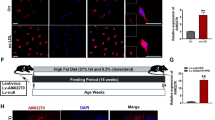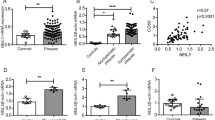Abstract
An apoE4 genotype is an important risk factor for cardiovascular and other chronic diseases. The higher cardiovascular disease risk of apoE4 carriers as compared to the apoE3 genotype has been mainly attributed to the differences in blood lipids between the two genotype subgroups. Recently, a potential protective role of the transcription factor Nrf2 in cardiovascular disease prevention has been suggested. In this study, we show that Nrf2-dependent gene expression is affected by the apoE genotype. ApoE4 vs. apoE3 mice exhibited lower hepatic Nrf2 nuclear protein levels. Furthermore, mRNA and protein levels of Nrf2 target genes including glutathione-S-transferase, heme oxygenase-1 and NAD(P)H dehydrogenase, quinone 1 were significantly lower in apoE4 as compared to apoE3 mice. Lower hepatic mRNA levels of phase II enzymes, as observed in apoE4 vs. apoE3 mice, were accompanied by higher mRNA levels of phase I enzymes including Cyp26a1 and Cyp3a16. Furthermore, miRNA-144, miRNA-125b, and miRNA-29a involved in Nrf2 signaling, inflammation, and regulation of phase I enzyme gene expression were affected by the apoE genotype. We provide first evidence that Nrf2 is differentially regulated in response to the apoE genotype.






Similar content being viewed by others
References
Heeren J, Beisiegel U, Grewal T (2006) Apolipoprotein E recycling: implications for dyslipidemia and atherosclerosis. Arterioscler Thromb Vasc Biol 26:442–448
Mahley RW, Weisgraber KH, Huang Y (2009) Apolipoprotein E: structure determines function, from atherosclerosis to Alzheimer's disease to AIDS. J Lipid Res 50(Suppl):S183–S188
Humphries SE, Talmud PJ, Hawe E, Bolla M, Day IN, Miller GJ (2001) Apolipoprotein E4 and coronary heart disease in middle-aged men who smoke: a prospective study. Lancet 358:115–119
Minihane AM, Khan S, Leigh-Firbank EC, Talmud P, Wright JW, Murphy MC, Griffin BA, Williams CM (2000) ApoE polymorphism and fish oil supplementation in subjects with an atherogenic lipoprotein phenotype. Arterioscler Thromb Vasc Biol 20:1990–1997
Boesch-Saadatmandi C, Niering J, Minihane AM, Wiswedel I, Gardeman A, Wolffram S, Rimbach G (2010) Impact of apolipoprotein E genotype and dietary quercetin on paraoxonase 1 status in apoE3 and apoE4 transgenic mice. Atherosclerosis 211:110–113
Jofre-Monseny L, Loboda A, Wagner AE, Huebbe P, Boesch-Saadatmandi C, Jozkowicz A, Minihane AM, Dulak J, Rimbach G (2007) Effects of apoE genotype on macrophage inflammation and heme oxygenase-1 expression. Biochem Biophys Res Commun 357:319–324
Mann GE, Bonacasa B, Ishii T, Siow RC (2009) Targeting the redox sensitive Nrf2-Keap1 defense pathway in cardiovascular disease: protection afforded by dietary isoflavones. Curr Opin Pharmacol 9:139–145
Zakkar M, Van der Heiden K, le Luong A, Chaudhury H, Cuhlmann S, Hamdulay SS, Krams R, Edirisinghe I, Rahman I, Carlsen H et al (2009) Activation of Nrf2 in endothelial cells protects arteries from exhibiting a proinflammatory state. Arterioscler Thromb Vasc Biol 29:1851–1857
Li J, Ichikawa T, Janicki JS, Cui T (2009) Targeting the Nrf2 pathway against cardiovascular disease. Expert Opin Ther Targets 13:785–794
Levonen AL, Inkala M, Heikura T, Jauhiainen S, Jyrkkanen HK, Kansanen E, Maatta K, Romppanen E, Turunen P, Rutanen J et al (2007) Nrf2 gene transfer induces antioxidant enzymes and suppresses smooth muscle cell growth in vitro and reduces oxidative stress in rabbit aorta in vivo. Arterioscler Thromb Vasc Biol 27:741–747
Wagner AE, Ernst I, Iori R, Desel C, Rimbach G (2010) Sulforaphane but not ascorbigen, indole-3-carbinole and ascorbic acid activates the transcription factor Nrf2 and induces phase-2 and antioxidant enzymes in human keratinocytes in culture. Exp Dermatol 19:137–144
Banning A, Deubel S, Kluth D, Zhou Z, Brigelius-Flohe R (2005) The GI-GPx gene is a target for Nrf2. Mol Cell Biol 25:4914–4923
Fischer A, Gaedicke S, Frank J, Doring F, Rimbach G (2010) Dietary vitamin E deficiency does not affect global and specific DNA methylation patterns in rat liver. Br J Nutr 104:935–940
Griffiths-Jones S, Grocock RJ, van Dongen S, Bateman A, Enright AJ (2006) miRBase: microRNA sequences, targets and gene nomenclature. Nucleic Acids Res 34:D140–D144
Gaedicke S, Zhang X, Huebbe P, Boesch-Saadatmandi C, Lou Y, Wiswedel I, Gardemann A, Frank J, Rimbach G (2009) Dietary vitamin E, brain redox status and expression of Alzheimer's disease-relevant genes in rats. Br J Nutr 102:398–406
Ernst IM, Wagner AE, Schuemann C, Storm N, Hoppner W, Doring F, Stocker A, Rimbach G (2011) Allyl-, butyl- and phenylethyl-isothiocyanate activate Nrf2 in cultured fibroblasts. Pharmacol Res 63:233–240
Collins AR, Lyon CJ, Xia X, Liu JZ, Tangirala RK, Yin F, Boyadjian R, Bikineyeva A, Pratico D, Harrison DG et al (2009) Age-accelerated atherosclerosis correlates with failure to upregulate antioxidant genes. Circ Res 104:e42–e54
Yang Y, Yang Y, Xu Y, Lick SD, Awasthi YC, Boor PJ (2008) Endothelial glutathione-S-transferase A4-4 protects against oxidative stress and modulates iNOS expression through NF-kappaB translocation. Toxicol Appl Pharmacol 230:187–196
Stephens JW, Bain SC, Humphries SE (2008) Gene-environment interaction and oxidative stress in cardiovascular disease. Atherosclerosis 200:229–238
Orozco LD, Kapturczak MH, Barajas B, Wang X, Weinstein MM, Wong J, Deshane J, Bolisetty S, Shaposhnik Z, Shih DM et al (2007) Heme oxygenase-1 expression in macrophages plays a beneficial role in atherosclerosis. Circ Res 100:1703–1711
Siow RC, Sato H, Mann GE (1999) Heme oxygenase-carbon monoxide signalling pathway in atherosclerosis: anti-atherogenic actions of bilirubin and carbon monoxide? Cardiovasc Res 41:385–394
Park EY, Cho IJ, Kim SG (2004) Transactivation of the PPAR-responsive enhancer module in chemopreventive glutathione S-transferase gene by the peroxisome proliferator-activated receptor-gamma and retinoid X receptor heterodimer. Cancer Res 64:3701–3713
Wang X, Wang Z, Liu JZ, Hu JX, Chen HL, Li WL, Hai CX (2011) Double antioxidant activities of rosiglitazone against high glucose-induced oxidative stress in hepatocyte. Toxicol In Vitro. doi:10.1016/j.tiv.2011.1002.1004
Tanaka Y, Aleksunes LM, Yeager RL, Gyamfi MA, Esterly N, Guo GL, Klaassen CD (2008) NF-E2-related factor 2 inhibits lipid accumulation and oxidative stress in mice fed a high-fat diet. J Pharmacol Exp Ther 325:655–664
Zhang YK, Yeager RL, Tanaka Y, Klaassen CD (2010) Enhanced expression of Nrf2 in mice attenuates the fatty liver produced by a methionine- and choline-deficient diet. Toxicol Appl Pharmacol 245:326–334
Carvalho-Wells ALJK, Gill R, Olano-Martin E, Lovegrove JA, Williams CM, Minihane AM (2010) Interactions between age and apoE genotype on fasting and postprandial triglycerides levels. Atherosclerosis 212:481–487
Habeos IG, Ziros PG, Chartoumpekis D, Psyrogiannis A, Kyriazopoulou V, Papavassiliou AG (2008) Simvastatin activates Keap1/Nrf2 signaling in rat liver. J Mol Med 86:1279–1285
Tili E, Michaille JJ, Cimino A, Costinean S, Dumitru CD, Adair B, Fabbri M, Alder H, Liu CG, Calin GA et al (2007) Modulation of miR-155 and miR-125b levels following lipopolysaccharide/TNF-alpha stimulation and their possible roles in regulating the response to endotoxin shock. J Immunol 179:5082–5089
Sangokoya C, Telen MJ, Chi JT (2010) microRNA miR-144 modulates oxidative stress tolerance and associates with anemia severity in sickle cell disease. Blood 116:4338–4348
Garg R, Gupta S, Maru GB (2008) Dietary curcumin modulates transcriptional regulators of phase I and phase II enzymes in benzo[a]pyrene-treated mice: mechanism of its anti-initiating action. Carcinogenesis 29:1022–1032
Shen G, Kong AN (2009) Nrf2 plays an important role in coordinated regulation of phase II drug metabolism enzymes and phase III drug transporters. Biopharm Drug Dispos 30:345–355
Mrkonjic M, Chappell E, Pethe VV, Manno M, Daftary D, Greenwood CM, Gallinger S, Zanke BW, Knight JA, Bapat B (2009) Association of apolipoprotein E polymorphisms and dietary factors in colorectal cancer. Br J Cancer 100:1966–1974
Acknowledgments
We thank the German Ministry of Education and Science (BMBF 0313856A, BMBF 0315397C) and the DFG Cluster of Excellence “Inflammation at Interfaces” for financial support. A.C.G. is supported by a grant from H. W. Schaumann foundation.
Disclosure statement
The authors declare that they have no competing interests.
Author information
Authors and Affiliations
Corresponding author
Rights and permissions
About this article
Cite this article
Graeser, AC., Boesch-Saadatmandi, C., Lippmann, J. et al. Nrf2-dependent gene expression is affected by the proatherogenic apoE4 genotype—studies in targeted gene replacement mice. J Mol Med 89, 1027–1035 (2011). https://doi.org/10.1007/s00109-011-0771-1
Received:
Revised:
Accepted:
Published:
Issue Date:
DOI: https://doi.org/10.1007/s00109-011-0771-1




